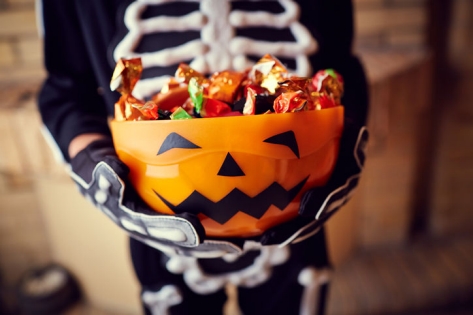
Trick-or-treat night is a thrilling time for kids. And what’s not to love about dressing up and getting gobs of candy from neighbors? However, spooky season can turn scary quickly when children have allergic reactions to their Halloween candy. Impacting 1-in-13 kids, allergic reactions in children, including to peanuts, tree nuts, milk, sesame and more, spike during Halloween.
John Oppenheimer, MD, an allergy and immunology specialist with Atlantic Health System, shares why allergic reactions increase during Halloween, how to spot an allergic reaction and what parents can do to help.
How to Spot an Allergic Reaction (And What to Do)
It’s often obvious when allergic reactions are happening. Children develop symptoms within an hour (or shorter) after eating food containing an allergen. These symptoms include:
- Hives
- Shortness of breath
- Swelling
- Throat irritation
- Upset stomach or diarrhea
- Weakness or passing out
If your child is having an allergic reaction involving more than one symptom or if they are having trouble breathing or swallowing, it’s time to use auto-injectable epinephrine (EpiPen) immediately. After using your EpiPen, you can use steroids or antihistamines as second-line therapy. Recent guidelines recommend against using antihistamines first as they may cover up symptoms.
“Unfortunately, food allergies are dose-related and a larger quantity leads to a more severe reaction,” says Dr. Oppenheimer. “Different people have different levels of sensitivity and may even react with a small quantity of food. If you’re ever uncertain, don’t eat it.”
How Parents Can Keep Their Kids Safe on Halloween
Parents may not know if their children have allergies until they eat a certain food and have a reaction.
“For many kids, Halloween is the first time they will be exposed to peanuts, tree nuts or other allergens. A child takes a bite and has a reaction,” says Dr. Oppenheimer. “For food-allergic children, allergies are like a time bomb. Every time they pick up an unknown food, it might send them to the ER.”
While legislation requires major allergens like sesame and milk to be labeled, allergens can hide in unexpected places. For example, baked goods, Asian food, protein bars, salads and some vegetarian foods can all hide tree nuts.
Dr. Oppenheimer recommends:
- Carrying an EpiPen in case of emergencies.
- Encouraging your kids not to eat candy until they get home and their haul can be inspected.
- Getting a medical alert bracelet for your child in case they have a reaction while they are separated from you.
- Having non-food treats like small amounts of money or coupons on hand for kids with food allergies. You can also give out hard candy that is often free of common allergens.
- Putting out teal pumpkins to let kids with food allergies know you have safe trick-or-treat options for them.
- Trading your child’s favorite, safe candy with them when they get home from trick-or-treating.
Most of all, says Dr. Oppenheimer, try to empower your child to take responsibility for managing their allergies.
“I often tell kids that food allergies are like Superman’s kryptonite,” says Dr. Oppenheimer. “One of the reasons Superman knows he’s so powerful is because he knows what he’s allergic to.”
Parents can also look to reliable resources for additional information on managing food allergies
Dr. Oppenheimer suggests Food Allergy Research & Education (FARE) as a resource for parents to have reliable information when it comes to food allergies.
“We want these kids to have a happy Halloween and for them not to have anxiety,” says Dr. Oppenheimer. “We see kids in the ER in the days after Halloween, but we would love for this to be a year where no one has to go to the ER.”
Be Proactive About Their Health
To stay safe and healthy, it's good to have a primary care provider who knows and understands your child's health history and wellness goals.